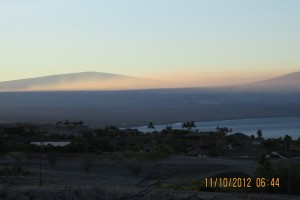VOLCANO WATCH: Dual Nature of Vog Results in Air Quality Variety Show

The summit of Mauna Loa (left) rises above the vog layer on the leeward side of the Island of Hawai‘i in November 2012. The flank of Hualālai is visible at right. USGS photo.
The first few months of 2016 have brought a range of wind and weather conditions to the Island of Hawai‘i. As is typical during strong El Niño events, there’s been a notable absence of trade winds and minimal rainfall. Periods of Kona winds (winds with a southerly component) interspersed with light and variable winds have brought noxious volcanic pollution (vog) to many parts of the island, as well as to our neighbor islands to the northwest.
Vog forms as volcanic gases bubble out of Kīlauea’s active lava lake at Halema‘uma‘u and from the vents and lava flows in and around Pu‘u ‘Ō‘ō. The main culprit in the formation of vog is sulfur dioxide gas (SO2), which is released in ample supply from the volcano. In 2015, Kīlauea released roughly 800,000 metric tons of the pungent gas, more than five times the amount released by the dirtiest coal-burning power plant in the United States.
The voluminous visible plumes emitted from Kīlauea are composed mainly of water vapor, carbon dioxide, and sulfur dioxide gases, as well as small amounts of ash, other gases, and particles. SO2 gas is invisible, but once released from the volcano, it reacts chemically in the atmosphere to form tiny liquid acid droplets and fine solid particles. These particles fall into a category of air pollution referred to as PM2.5, particulate matter with diameters of 2.5 microns (0.0001 inch) or less—smaller than the diameter of one strand of a spider’s web or of a human hair. These tiny particles, which are good at scattering light, are largely responsible for the visible haze associated with vog.
The term “vog” is generic, with the actual proportion of gases and particles dependent on how much time it has had to react in the atmosphere. Close to the gas emission sources, vog can contain significant amounts of unreacted SO2gas. The longer SO2 gas has to react in the atmosphere, the more complete the SO2 gas to particle conversion is. So, farther away from the volcano, vog is composed primarily of particles.
The dual gas and/or particle nature of vog means that people are exposed to different vog cocktails, depending on location. In areas closer to Kīlauea, such as Ocean View and Pāhala, which are downwind of the volcano during prevailing northeasterly trade winds, people are chronically exposed to a mixture of SO2 gas and particles. During non-trade wind conditions, communities in the Hilo and Puna districts are frequently voggy, and, because they are relatively close to the emission sources, there is also a mixture of SO2 gas and particles in the vog. On neighbor islands and in communities on the western and northern areas of Hawai‘i Island, people are mainly exposed to particles.
According to the U.S. Environmental Protection Agency, high concentrations of SO2 gas and particles can cause a variety of effects, including aggravation of existing heart and lung disease, increased asthma symptoms, emergency department visits, and hospital admissions for respiratory illnesses. Even healthy people can experience eye, nose, and throat irritation, coughing, phlegm, chest tightness, and shortness of breath.
In Hawai’i, current vog concentrations are expected to have the highest impact on sensitive populations—people with preexisting medical conditions, the elderly, and children. However, minor symptoms are reported by many people exposed to vog, consistent with the effects expected from SO2 and particle exposures.
Many websites provide information on current SO2 gas and particle conditions, protective actions for when pollution levels are elevated, and other air quality data.
The Hawaii Department of Health provides 15-minute SO2 gas concentration data and PM2.5 data. Additionally, PM2.5 data and advice are also available through the multi-agency AirNow website.
SO2 gas and PM2.5 data for Hawai‘i Volcanoes National Park are available here.
The Volcano Measurement and Prediction Project provides a modeled two-day forecast for volcanic SO2 gas and particles.
Finally, the International Volcano Health Hazard Network provides additional information.
Kīlauea continues to release large amounts of volcanic gas each day. Learning to identify when vog is present and how to protect ourselves and our families is a sensible adaptation to living with the active volcano in our backyard.
Volcano Activity Updates
Kīlauea continues to erupt at its summit and East Rift Zone. During the past week, the summit lava lake was relatively stable, with the lake level around 29-35 m (95–114 ft) below the vent rim within Halema‘uma‘u Crater. On the East Rift Zone, scattered lava flow activity remains within about 7.1 km (4.4 mi) of Puʻu ʻŌʻō and is not currently threatening nearby communities.
Mauna Loa is not erupting. Seismicity remains elevated above long-term background levels. GPS measurements show continued deformation related to inflation of a magma reservoir beneath the summit and upper Southwest Rift Zone of Mauna Loa, with inflation recently occurring mainly in the southwestern part of the magma storage complex.
No earthquakes were reported felt on the Island of Hawai‘i during the past week.
Volcano Watch is a weekly article and activity update written by scientists at the U.S. Geological Survey`s Hawaiian Volcano Observatory.













